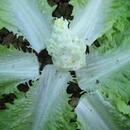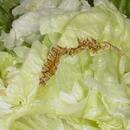All

Insect pressure is a term indicating the presence of insects in lettuce fields. The number of insects can vary, depending on location and temperatures. Fall is typically the worst time for insect infestations. Many insect populations start in other fields such as cotton and melons; when these crops mature, they move to alternative harvesting areas like lettuce.
Product inspections in the field and post-harvest are fundamental to maintaining the integrity of the Markon First Crop, Ready-Set-Serve, and Markon Essentials brands. Markon believes in the adage "trust, but verify," so to supplement our written specifications, inspectors are at work six days a week to approve or reject potential fields for Markon First Crop lettuce, leaf, strawberry, potato and celery items, plus many other vegetable crops. Broccoli, cauliflower, apples, and onions are also inspected. In-house inspectors visit cold rooms three times per week to monitor post-harvest storage temperatures and weights for leaf, lettuce and many vegetable items.
For more information, please watch the "Day In the Life of a Markon Inspector" video.
What is Integrated Pest Management (IPM)?
An IPM system seeks to implement socially responsible and economically feasible methods of reducing agricultural pests and promoting sustainable agriculture for the preservation of the environment. Management options include
- Cultural: crop rotation
- Mechanical: cultivating beneficial weeds
- Biological: releasing beneficial insects or parasites to control other pests
- Genetic: use of plant disease-resistant varieties
- Chemical: herbicides, insecticides, fungicides
Pros
- Potential for increased production and improved quality of crops
- Lower incidences of pesticides in the environment
- May reduce farming costs
Cons
- Live and/or dead pests in harvested produce
- Time consuming
- Inconsistent results
For information about IPM in general: National Integrated Pest Management Network

Internal burn is when heat and/or rapid growth causes browning on lettuce's inner leaves; tip burn is the same condition occurring on the outer tips of leaves. Both problems decrease shelf-life and can lead to breakdown within the lettuce head. They are most prevalent in summer months, when temperatures are extremely high. Both conditions are usually caused when there is rapid growth and plants cannot get sufficient quantities of water to various sections of the head.
What is Irradiation?
A process in which high energy rays pass through packaged food. The process destroys dangerous microbes within and on the surface, including foodborne illnesses such as E. coli 0157:H7, Salmonella, Campylobacter, Shigella, Cyclospora, and Listeria. The process also eliminates pests (such as fruit flies) and slows foods' natural ripening process, extending shelf-life. Nutritional changes are insignificant.
Critics claim that studies of irradiated foods are inconclusive or outdated, and that studies point to the mutation of genes in both animals and humans.
What Methods are Used in the U.S.?
-
Electronic beam, or e-beam technology
- Most prevalent type used today
- Used by over 75% of ground beef producers and 50% of poultry processors
- Purchased by U.S. Postal Service to safeguard mail supply
- No radioactivity is involved
- Turned off and on with a switch
- In use for 15 years
-
X-Ray technology
- Most used in the irradiation of produce
- Stronger version of the medical x-ray machine (can penetrate deeper than e-beam, but not as deep as gamma rays)
- No radioactivity is involved
- Turned off and on with a switch
- More effective than e-beams on products that have high water density or inconsistent shapes (such as most fruits and vegetables)
-
Gamma ray radiation
- In produce industry, most often used on dried herbs and spices
- Also used in medical supplies, dental equipment, and household products
- Rays are emitted by radioactive substance (either Cobalt 60 or Cesium 137)
- Elements give off high-energy photons that can penetrate solids
- Gamma rays do not make food, or anything else, radioactive
- In use for over 30 years
- Does use radioactive materials
Foods Currently Approved for Irradiation
- Tropical Fruits & Vegetables, Imported (2002, USDA)
- Meat (1997 FDA, 1999, USDA)
- Poultry (1990, FDA, 1992, USDA)
- Herbs and spices (1986, FDA)
- Fruits and vegetables (1986, FDA)
- Pork (1986, FDA)
- White potatoes (1964, FDA)
- Wheat flour (1963, FDA)
Does Markon Sell Irradiated Produce?
At this time, no Markon branded products are irradiated. In general, the degree of irradiation needed to kill pathogens in produce can damage it (for example, cause lettuces to wilt).
For More Information: Centers for Disease Control and Prevention
